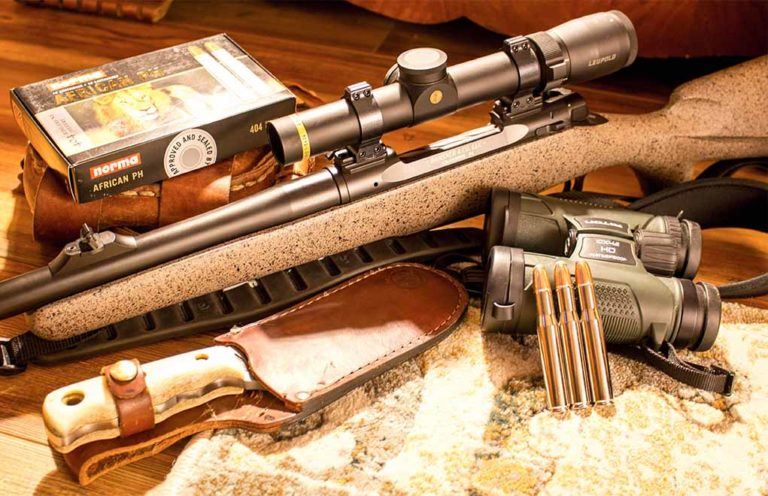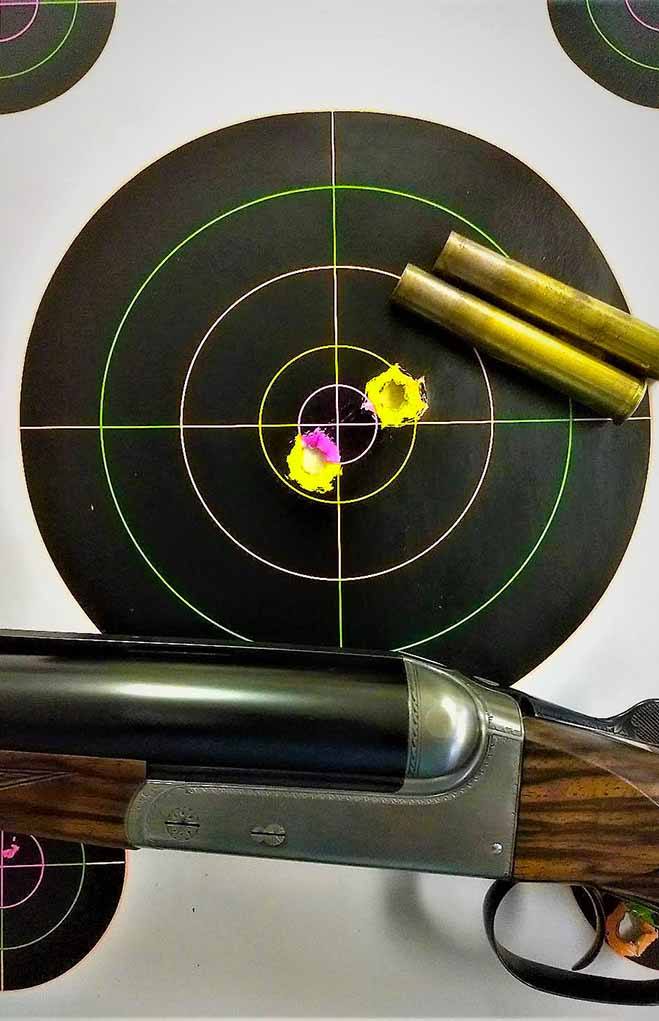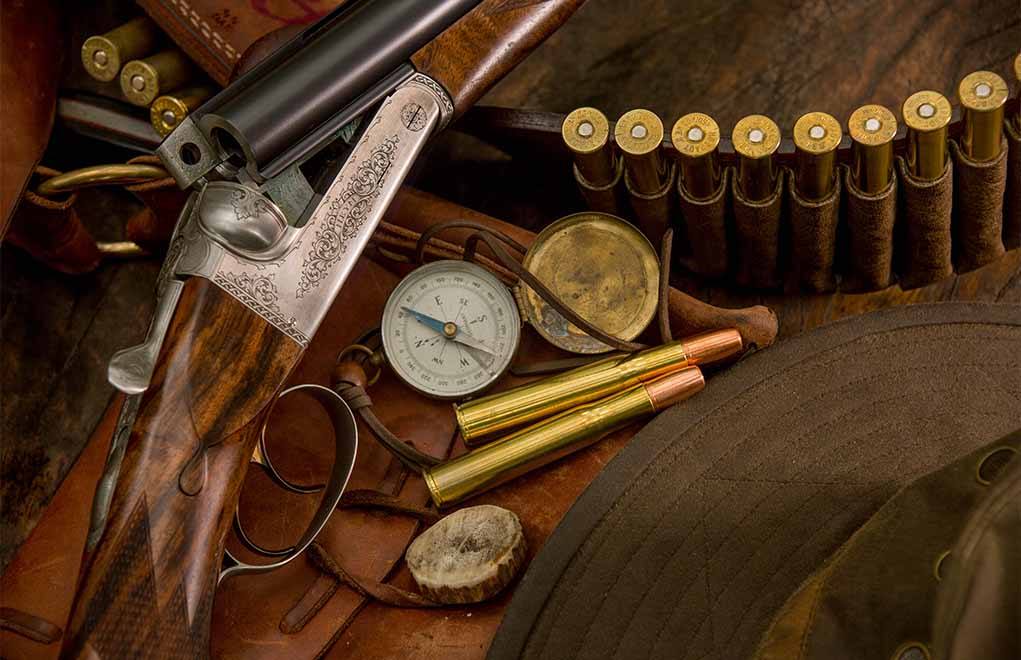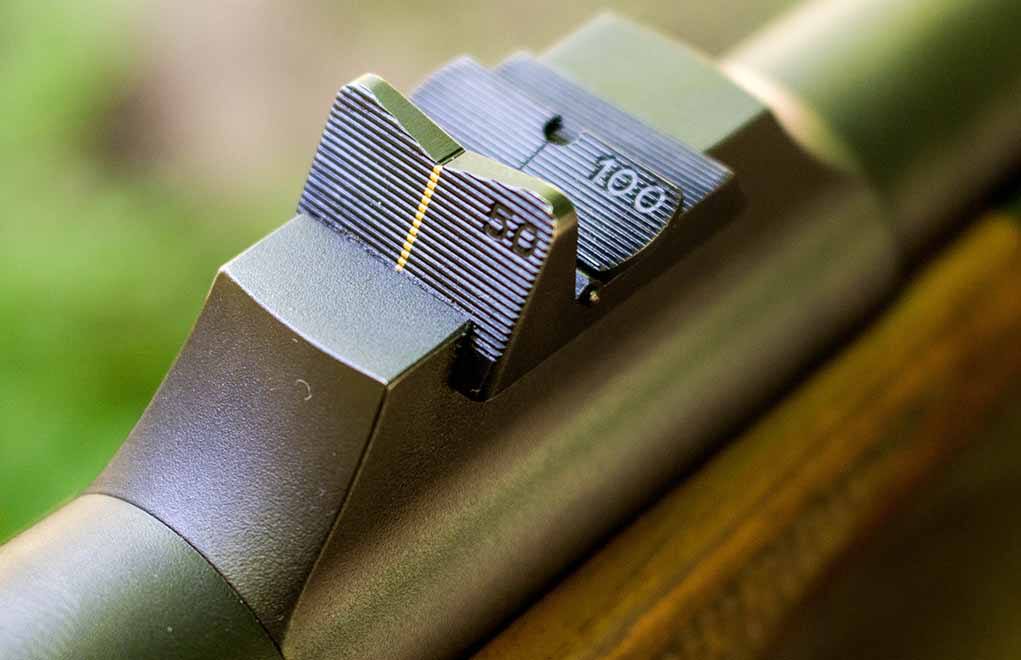

Not all giants are created equal, so take your time in picking the right big-bore cartridge and rifle for your needs.
How To Shop For The Perfect Big-Bore Rifle:
- Look for a balance of trajectory, energy and flexibility.
- Do your research to see if the cartridge is adequate for your purposes and meets local game regulations.
- Try as many big-bore rifles as possible in as many calibers as possible to find the right combination.
I have a penchant for big-bore rifles and cartridges. It’s not necessarily that I’m in love with a ton of recoil (although I don’t mind it); it’s that grabbing for one of my big-bore rifles usually means I’m heading on a hunt for dangerous—or at least very large—game.
Let’s get this out of the way early on: You can hunt 95 percent of the world’s game species with a cartridge no bigger than 7mm or .30 caliber. Premium bullets give the best balance of expansion and penetration we’ve ever experienced, and a good heavy-for-caliber 7mm or .30 is a formidable projectile. So, it’s plain to see that your dangerous-game rifle will probably be the least used. Nevertheless, it’s the most important choice of rifle—when you need it, you really need it.
Your choice of hunting destination and the animals you intend to hunt will play a large role in the choice of a big-bore rifle/cartridge combination.

The quintessential brown bear rifle might look a lot like the quintessential Cape buffalo rifle, but there are subtle differences. And, a cartridge that could handle all of North America (including Alaskan big game) might not be legal for some African countries. A rifle for Australian buffalo and assorted bovines will be very close to that which handles the African heavyweights, but there are decisions to be made within that realm as well.
Alaska And The Brown Bear
Understand that the largest brown bear or bison can be taken cleanly with a .338 Winchester Magnum and the like, because it has the ability to deliver a 250-grain bullet at respectable velocities (2,600 fps or better), yet shoots flat enough to take mountain goat, sheep or caribou. I have many friends who hunt or guide in the 49th state, and they generally agree that the .388 WM is a good minimum for big brownies. I would feel better with a .375 H&H in hand, and when I hunted Alaskan brown bear, I carried a bolt-action .404 Jeffery, along with 450-grain Norma ammunition.
Some guides who frequently dig bears out of the thick stuff carry .458 Winchester Magnums or .458 Lotts, because the 500-grain bullets settle an argument quickly. The .45-70 Government will still get the job done, although shots out past about 125 or 150 yards become quite a challenge, and the energy drops off quickly.
There are many who enjoy a lever gun in Alaska, but for the most versatile choice for a visiting sportsman, a weatherproof bolt-action can’t be beat.

As much as I love the .404 Jeffery, I think the .375 H&H or .375 Ruger is more flexible—they can shoot flat and will handle bullets of up to 350 grains—and either would make the perfect all-around Alaskan choice. I understand Ruger is reintroducing the Hawkeye Alaskan, and that rifle makes an effective, yet affordable, choice.
If you like the big .45-calibers, so be it, but realize there’s a bit of a trajectory handicap. Should a hunter want more than a .375 offers for Alaska, the .404 or one of the .416s is an excellent balance.
The Dark Continent And Down Under
Looking at big-bore rifles for African and Australian hunting, you’ll find a bit of overlap with the Alaskan choices. Many African countries use the .375-inch bore diameter as the legal minimum for buffalo, hippo and elephant. Some include lion and leopard in the mix, and Zimbabwe uses the 9.3mm as a minimum.

In the British sense of the term, the big-bore cartridges don’t start until the .45s. The .375, .416 and .404 were considered medium-bores. I think we’ve proven that the line has been moved, because the .375 H&H is fully capable of taking any game animal on Earth; and, with modern bullets, the 9.3mm cartridges should be cleared for any dangerous-game hunting.
For the hunter who wants to have one big-bore rifle to hunt African game, as well as the huge bovines of Australia, a bolt-action .375 makes logical sense. However, there’s a difference between “capable” and “ideal,” and that distinction has been argued for decades.
The Cape buffalo is the most affordable and most popular of the African dangerous-game species. Weighing an average of 1,400 pounds, this bovine, known as “Black Death,” is famed for its tenacity and ability to soak up lead. I can attest to the fact that the 400-grain bullets of the .416s and .404 have a much more dramatic effect than the 300-grain bullets of the .375s. The .458s and .470s are even more effective, driving 500-grain slugs. But, of course, the increased throw weight comes at the price of additional recoil.

If an elephant is on your dream list (and it’s fantastic hunting that does much more good than harm to the approved populations), you might definitely want something in the mid- to high .40s or even into the .500s. I have become friends with a good number of the continent’s elephant hunters, and they all like some sort of .500, whether in a double chambered for the .500 Nitro Express or in a bolt-action .500 Jeffery. These are great elephant (and buffalo) cartridges.
However, the role of professional hunter is not that of the client, and these rifles are specifically chosen for mopping up messes at close range. For the client (you or me), I feel that a dangerous-game rifle needs to be a bit more flexible with regard to distance—and utterly manageable. Although professional hunters carry “big sticks,” they can be too much gun for the average client.
A big part of the decision-making process is to be honest with yourself about how much recoil you can truly handle. A .375 bullet in the right place is worth 10 .470s in the wrong place. Even the choice between a bolt-action, single-shot or double rifle will have a lot to do with your physical capabilities; carrying a 12-pound double for eight miles in the heat is more difficult than a 9-pound bolt gun.
Choosing And Setting Up A Big-Bore Hunting
Most of the big-bore dangerous-game rifles are going to be bolt-action; they are light, rugged and accurate. Topped with a good low-power scope, a bolt-action rifle can be effective out to 250 yards and maybe more. I think a scope is important for placing shots accurately: Buffalo are sometimes shot out to 125 yards, and bears are shot farther than that. However, the ability to remove the scope to access iron sights is imperative.

For this application on a bolt-action rifle, I have found Talley’s detachable rings to be among the best I’ve seen. They reliably return to zero and can handle the nastiest recoil. I like a scope in the range of 1-4x, 1.5-5x or 1-6x to keep the field of view wide for fast target acquisition. A good big-bore should also have good iron sights, which the shooter has put on paper and is comfortable using.
I like my dangerous-game bolt-action rifles to be controlled-round-feed (CRF), because I feel it’s the most rugged. I’ve heard the arguments about the strength and reliability of modern push-feed designs, and perhaps I’m old fashioned, but I like the over-designed qualities of the Mauser 98 and its clones. My Heym Express .404 Jeffery uses a proprietary action that is larger and stronger than even the 98 Mauser. It’s my favorite rifle ever. The Winchester 70, Dakota 76, Rigby Big Game, Montana 1999 and the CZ550 are all examples of reliable CRF actions.
Single-shot rifles, such as the popular Ruger No. 1, are often chambered for big-bore cartridges. They will work, but you might be asking for a backup shot from your professional hunter. If you know that going in and are comfortable with that, so be it.

If you choose the romance and fast second shot of a double rifle, I’m the last person to find fault with you. I’ve done several hunts with a double rifle as my big-bore, and it’s a wonderful experience. They aren’t cheap (at least the good ones aren’t), and both stock fit and rifle balance are crucial with a double rifle. So is regulation—the way the pair of barrels is set to hit the same point of impact at a certain distance—and you do get what you pay for in the double-rifle world.
Like a bolt-action, the double rifle is available in calibers from 9.3x74mm and .375 flanged up to .600 and even .700 NE, although most hunters choose a cartridge somewhere in the middle. The .450-400 3-inch is very popular, because it gives great penetration without the punishing recoil. Some find it a bit light for elephant but good for buffalo. I used it to take an excellent buffalo in Mozambique and had no complaints.
The .450 NE set the standard back in 1898, and it remains a good choice for a double rifle for all species. However, I chose the .470 NE for my Heym 89B double rifle, because ammunition is more readily available. Both drive a 500-grain bullet at 2,150 fps, and while the .450 offers a better sectional density figure, there are absolutely no flies on the .470 NE. The .500 NE gives a bit more bullet weight (570 grains), a bit more energy (5,800 ft-lbs) and more frontal diameter, which is why it remains so popular among professional hunters. Sliding up the scale to the .577 NE, you will see a 750-grain bullet at 2,050 fps for 7,000 ft-lbs of energy—with recoil to match.

The classic configuration of the double rifle is a bold front bead and a wide-V rear sight. The rifle might have folding leaves for farther distances, but the stationary rear sight should be regulated for 60 to 100 yards. Adding a red-dot sight (I love the Trijicon RMR) adds a new dimension to the double rifle. I definitely prefer two triggers over a single trigger—one of the original benefits of the double in wild country was that you essentially had two rifles in one.
Cartridge Choice
There are volumes written on the proper cartridge choice for dangerous game, so I can’t cover it all in a magazine article. Look at a few key points when choosing a cartridge: bullet weight, recoil-generated (compared to that which you can handle), availability and applicability.
A .577 NE is not a 400-yard cartridge, and a .338 Winchester is not designed for elephant. I love flexibility, which is why I praise the .375 H&H so highly. With lighter bullets, it can readily take deer, hogs, elk and plains game. With heavy bullets, it will take everything else. However, 5,000 ft-lbs handle buffalo and elephant better than 4,000 ft-lbs, and 400- and 500-grain bullets make a better choice for dangerous-game animals than 300—providing (and this is the most important point) the shooter can effectively wield a cartridge of that magnitude.
I look for a balance of trajectory, energy and flexibility and have found many that fit the bill for me: the .375 H&H, .416 Remington Magnum, .404 Jeffery and the .470 NE.

Do your research, and you might come up with the same answers I did, or you might find a different one that appeals to you. There are many correct answers to the same question. You’ll want a cartridge that can deliver a bullet with a sectional density figure at .300 or above at a velocity of 2,100 to 2,500 fps. This doesn’t overstrain the bullet … or your shoulder.
The best advice I can give you is to try as many big-bore rifles as possible. While this might sound extremely difficult, many big-bore aficionados are eager to help out a fellow shooter. Usually just for the price of the ammo, you will find an experienced big-bore shooter who will let you try their particular favorite. I have more big-bores than I need, but I truly enjoy shooting them.
My own choices? A Winchester 70 in .416 Remington Magnum, Heym Express by Martini in .404 Jeffery, Bansner Custom in .404 Jeffery and a Heym 89B double rifle in .470 NE. (My wife stole my Legendary Arms Works .375 H&H, but I get to shoot it if I behave well.) If I had to choose just one, it would be that Heym Express .404 … but thankfully, I don’t have to choose.
The article originally appeared in the June 2019 issue of Gun Digest the Magazine.

Next Step: Get your FREE Printable Target Pack
Enhance your shooting precision with our 62 MOA Targets, perfect for rifles and handguns. Crafted in collaboration with Storm Tactical for accuracy and versatility.
Subscribe to the Gun Digest email newsletter and get your downloadable target pack sent straight to your inbox. Stay updated with the latest firearms info in the industry.

![Best Concealed Carry Guns In 2025 [Field Tested] Wilson Combat EDC X9S 1](https://gundigest.com/wp-content/uploads/Wilson-Combat-EDC-X9S-1-324x160.jpg)


![Best 9mm Carbine: Affordable PCCs [Tested] Ruger Carbine Shooting](https://gundigest.com/wp-content/uploads/Ruger-Carbine-Shooting-100x70.jpg)
![Best AR-15: Top Options Available Today [Field Tested] Harrington and Richardson PSA XM177E2 feature](https://gundigest.com/wp-content/uploads/Harrington-and-Richardson-PSA-XM177E2-feature-100x70.jpg)
